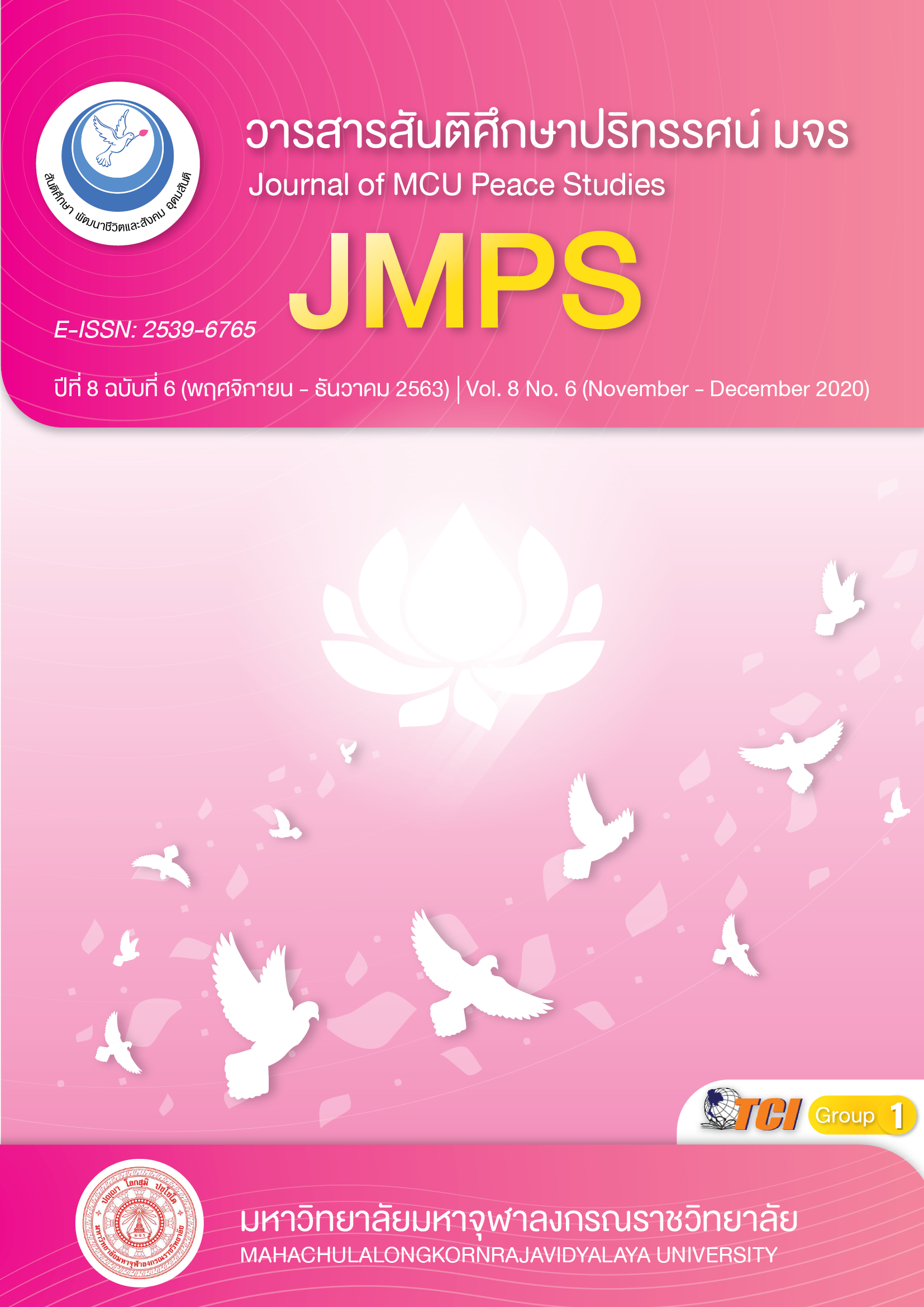การรื้อฟื้นความทรงจำร่วมเกี่ยวกับเจ้าฟ้าในรัฐฉานของชาวไทใหญ่ ในต้นศตวรรษที่ 21
Main Article Content
บทคัดย่อ
บทความวิจัยนี้มีวัตถุประสงค์เพื่อศึกษาการรื้อฟื้นความทรงจำร่วมเกี่ยวกับเจ้าฟ้าในรัฐฉานของชาว ไทใหญ่ ประเทศพม่าในต้นศตวรรษที่ 21 งานวิจัยนี้ใช้วิธีวิทยาการวิจัยเชิงคุณภาพ โดยเก็บรวบรวมข้อมูลเชิงเอกสาร การสังเกต และสัมภาษณ์ผู้เกี่ยวข้องในพื้นที่เมืองสีป้อ รัฐฉาน ประเทศพม่า โดยเลือกสัมภาษณ์ผู้ให้ข้อมูลสำคัญแบบเจาะจง ที่มีลักษณะเฉพาะตามวัตถุประสงค์ของงานวิจัย ประกอบด้วย เจ้าอาวาสวัดไทใหญ่ 3 ท่าน เครือญาติเจ้าฟ้า 2 ท่าน สมาชิกสมาคมการศึกษาและวัฒนธรรมไทใหญ่ จำนวน 3 ท่าน นักวิชาการและครูสอนภาษาไทใหญ่ จำนวน 3 ท่าน นักการเมืองชาวไทใหญ่ จำนวน 2 ท่าน และนำข้อมูลทั้งหมดมาสรุปเนื้อหา ในเชิงพรรณนาอย่างมีระบบตรงตามประเด็นที่ศึกษา ผลการศึกษาพบว่า 1) นโยบายการเปิดประเทศของรัฐบาลพม่า ก่อให้เกิดมาตรการการผ่อนคลายสื่อและสิ่งพิมพ์ซึ่งเป็นสื่อแบบเดิม ทำให้ทำให้ชาวไทใหญ่รับรู้ข่าวสารได้อย่างเสรี อีกทั้งการเปิดเสรีด้านโทรคมนาคม ทำให้สื่อสมัยใหม่มีบทบาทในการต่อการรับรู้ของชาวไทใหญ่อย่างรวดเร็ว โดยเฉพาะแหล่งข้อมูลออนไลน์คือเฟซบุ๊ก 2) กลุ่มชาวไทใหญ่ซึ่งเป็นชนชั้นสูงในชุมชน คือ เครือญาติของเจ้าฟ้า พระสงฆ์ นักวิชาการชาวไทใหญ่ ผู้รู้ในชุมชน นักการเมืองไทใหญ่ มีบทบาทต่อการรื้อฟื้นความทรงจำร่วมเกี่ยวกับเจ้าฟ้าขึ้นมาใหม่ เห็นได้จากมีการเปิดพื้นที่ความทรงจำที่เกี่ยวกับเจ้าฟ้าขึ้นในรัฐฉาน คือ หอเจ้าฟ้า วัดไทใหญ่ อนุสาวรีย์เจ้าฟ้า ศาลนัตไทใหญ่ โดยมีสื่อแบบเดิมและสื่อสมัยใหม่ เป็นเครื่องมือที่ทำให้เกิดการรื้อฟื้นความทรงจำร่วมเกี่ยวกับเจ้าฟ้าในรัฐฉานของชาวไทใหญ่ ในต้นศตวรรษที่ 21
Article Details
ทัศนะและความคิดเห็นที่ปรากฏในบทความในวารสาร ถือเป็นความรับผิดชอบของผู้เขียนบทความนั้น และไม่ถือเป็นทัศนะและความรับผิดชอบของกองบรรณาธิการ ยินยอมว่าบทความเป็นลิขสิทธิ์ของวารสาร
เอกสารอ้างอิง
Appadurai, A. (2000). Modernity at Large: Cultural Dimensions of Globalization. (5th Ed.). USA: University of Minnesota.
Chen, C. F. (2013). New wave of internet attacks on Myanmar. Retrieved February 2, 2020, from https://www.posttoday.com/world/246673.
Chotisut, K. (2016). Aung San: Dynamic of Social Memory Management of the Myanmar Government. Proceeding in the 2nd National Conference of Networking of History and Sociology and Anthropology in the Southern of Thailand, “Sciences of Memory and Arts of Forgotten”. Pattani: Prince of Songkla University, Pattani Campus.
Eawsriwong, N. (2014). Thai Nation, Thailand, Student books and Monuments On Culture, State and Consciousness. (3rd Ed.). Bangkok: Matichon Press.
Fisher, J. (2016). Twilight over Burma: Myanmar censors pull film from festival. Retrieved April 15, 2020, from https://www.bbc.com/news/world-asia-36535629.
Halbwachs, M. (1992). On Collective Memory. edited and translated by Lewis Coser. (1st ed.). Chicago: University of Chicago Press.
Hom, H. (2020). A new Generation calls for answers to Hsipaw prince’s 58-year disappearance. Retrieved April 15, 2020, from https://www.shorturl.at/hmT06.
HUMAN RIGHT WATCH. (2013). Reforming Telecommunications in Burma. Human Rights Watch. Retrieved February 2, 2020, from https://www.hrw.org/sites/default/files/reports/burma0512_ForUpload.pdf.
Jiratikorn, A. (2008). Migration, Media Flows and the Nation of Shan in Thailand (Doctoral Dissertation). University of Texas at Austin. Texas.
Jiratikorn, A. (2015). Transnational public areas, politics, about the area of Tai Yai migrant workers In Chiang Mai. (1st Ed.). Chiang Mai: Chiang Mai University.
Kaiser, C. (2016). Book Publishing Market Overview: Myanmar’s Challenges and Potential. Retrieved July 15, 2019, from https://publishingperspectives.com/2016/12/book-publishing-market-overview-myanmar/.
Leach, E. (1954). Political systems of highland Burma: a study of Kachin social structure. (1st ed.). Massachusetts: Harvard University Press.
Ministry of Information. (2008). Constitution of the Republic of the Union of Myanmar (2008). Retrieved July 15, 2019, from http://www.burmalibrary.org/docs5/Myanmar_Constitution-2008-en.pdf.
Preecharush, D. (2015). Shan State: A Strategic Handbook on Politics and Military. (1st Ed.). Bangkok: Thammasat University Press.
Samarajiva, R. (2016). Telecom is Biggest Attractor of FDI in Myanmar. Retrieved February 2, 2020, from http://lirneasia.net/farmhouse/2016/12/telecom-is-biggest-attractor-of-fdi-in-myanmar/.
SHAN. (2016). Banning of film on Shan Prince “irrational” says nephew Khun Tun Oo. Retrieved April 15, 2020, from https://www.shorturl.at/hmT06.
Slideshare. (2019). Digital 2019 Myanmar (January 2019). Retrieved April 15, 2020, from https://www.slideshare.net/DataReportal/digital-2019-myanmar-january-2019-v01.
Soe, L., Htwe. (2017). The Role of Ethnic Media in the “NEW MYANMAR”. Chiang Mai: Regional Center for Social Science and Sustainable Development (RCSD) Chiang Mai University.
Tai Yai Citizen 1. (2017). Tai Yai teacher at Hseni. Interview, July, 24.
Tai Yai Citizen 2. (2019). Historian and writer. Interview, March, 29.
Tai Yai Citizen 3. (2019). Leader of SNLD Party. Interview, May, 21.
Tai Yai Citizen 4. (2018). A book shop owner. Interview, December, 19.
Tai Yai Citizen 5. (2019). Head of the Taiyai Education and Culture Association at Hsipaw. Interview, May, 16.
Tai Yai Citizen 6. (2018). Abbot of Wat Hua Nam at Hsipaw. Interview, December, 13.
Tai Yai Citizen 7. (2019). Guardian of Sawbwa hall at Hsipaw. Interview, May, 18.
Thant Myint-U. (2017). The River of Lost Footsteps: A Personal History of Burma. Bangkok: River books Press.
Thaw, K. (2014). Literary Criticism, Critics and Censorship in Myanmar. Myanmar Studies Journal, 3, 61-83.
TransborderNEWS. (2015). Burmese Internet Cafe Sluggish After people use the internet on mobile phones. Retrieved February 2, 2020, from https://transbordernews.in.th/home/?p=6792.
Trautwein, C. (2015). Myanmar named fourth-fastest-growing mobile market in the world by Ericsson. Retrieved February 2, 2020, from https://www.mmtimes.com/business/technology/17727-myanmar-named-fourth- fastest-growing-mobile-market-in-the-world-by-ericsson.html.
Tun, S. (2013) . Why Invest In Myanmar? and other Notable Legal Articles. Yangon: Wisdom House Publishing.


